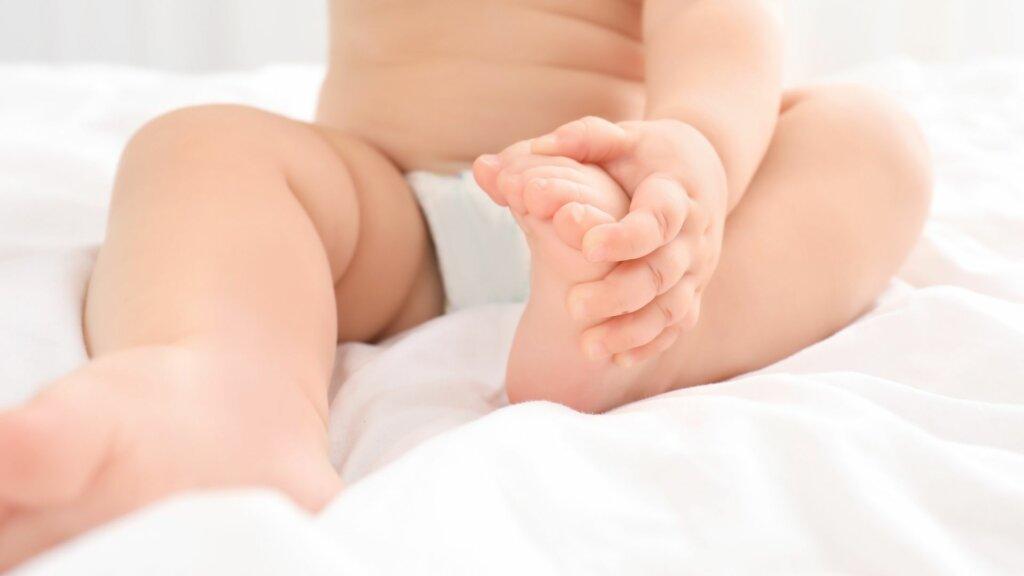Child development
from 8 – 18 month of life
As each child’s PACE OF DEVELOPMENT may be slightly different, be sure to learn about the DEVELOPMENTAL WINDOWS, i. e. TIME PERIODS in which a particular skill should appear.
The second half of the first year of life is all about learning locomotion – from turning and belly crawling to the position on all fours and walking.
Around the age of 8 months, the child assumes the position on all fours. Although it is still a difficult position, the baby makes the first attempts to shift the body weight by rocking – first backwards, then backwards and forwards and to the sides. Initially, every attempt to move in this position ends with a fall on the tummy, but over time, the child gets better at it so moving around is usually already possible by the end of the 8th month of life.
At first, the baby moves around on all fours with caution – by placing their knees under the tummy and chest, but as he or she masters this ability, the knees move backwards in relation to the hips.
Around the same time, the child begins to experiment with assuming the sitting position on his or her own. From all fours or propping on one side, the baby first moves to the side-sitting position and then is able to sit straight.

However, the child doesn’t sit in place for long. The possibility of moving around is definitely more interesting. At the end of the 9th month, the child makes the first attempts at upright standing – by holding onto the furniture or from the position on all fours by kneeling. At first, he or she stands unsteadily, with the feet placed wide apart – sometimes, even on tiptoes.
The first attempts to move sideways look like this: the child shifts the body weight and, sidestepping, cruises along the furniture. The hips and shoulders are not yet rotated in relation to each other, so the walk may look stiff and not very “elegant”.
The time between the 8th and 18th month of life is about perfecting the skills gained in the previous months and learning to walk.
The child is already able to move around on all fours, stand by the furniture and cruise along it. In the following months, he or she gets more and more confident – lets go of the hands more often and tries to stand on their own. This is all still quite wobbly, but day by day, it gets better. You can notice equilibrium responses throughout the whole body, including the feet.
Around the age of 10 months, the child, standing by the furniture, begins to slightly rotate the torso from side to side and move in different directions. He or she also tries to squat and sits carefully on the ground. Around the age of 12 months, the baby takes their first steps forward. The steps are short, quick and on a rather wide base.
Initially, the little one walks very short distances, but as time passes, he or she is able to walk further. The baby can easily get up from various positions – from kneeling, all fours and squatting. As the development proceeds, the “base” on which the child walks becomes narrower and the steps become longer.
What can we expect from a child between 8th and 18th month of life?
In lying on the back:
- the baby is already able to do everything he or she learned in the previous months – they can play in the midline of the body and easily reach both hands towards toys, but now this movement doesn’t affect the position of the rest of the body. He or she can move a toy from hand to hand, reach for it diagonally, rotate, grab their feet and put the toes in their mouth. Holding the legs, the baby positions the pelvis at an oblique angle to the hips. After this period, the baby can already do everything he or she was supposed to learn in this position, so now they can focus on achieving new skills.
In lying on the belly:
- the child props up on straightened arms, rotates around the axis of the body, pushes off the ground in a side position and is able to play while doing so,
- crawls – initially backward and then forward. Crawling should involve shifting the body weight once to the right and once to the left side,
- makes first attempts to assume the position on all fours, rocks back and forth and starts to move around in it,
- at the end of this period, the baby assumes the side-sitting position on his or her own,
- at first, the baby moves on all fours cautiously, but as he or she masters the ability of shifting the body weight and balancing it, moving around becomes much more easier,
- makes first attempts to stand up and walk on his or her own – at first by cruising along furniture, later without any support,
- the child actively and willingly changes positions – is able to turn from the back to the belly and vice versa, assumes the position on all fours, moves around in it, crawls, rotates around the body axis, plays while lying on the side, stands up holding onto the furniture as well as on their own, is able to sit straight (i.e. puts an equal amount of weight on both buttocks and keeps the back and the head straight),
- the baby is able to easily move from sitting to the position on all fours and vice versa – changing positions isn’t problematic,
- the baby gets more curious about the world and is eager to discover new places.
What should raise a red flag?
- tensing up, arching backwards,
- a visible preference of one body side – the baby reaches towards toys usually with the same hand, turns the head to one side, the head isn’t straight but one ear is inclined more towards the shoulder, head flattening appears,
- the child crawls only on one side, is unable to shift the body weight alternatively to both sides,
- the baby doesn’t play with their feet, puts them on the ground in the frog position or crosses legs when they’re straightened,
- there is little activity against the force of gravity – the child is reluctant to reach out their hands in front of the body,
- while turning from the back to the belly, the baby arches backwards as if he or she wanted to push off the ground with their head,
- in lying on the tummy, he or she has difficulty with propping up, keeps the hands close to the body, doesn’t push off the ground on straightened arms and it’s visible that the extensor muscles work really hard but the baby is still unstable in this position,
- during sitting, the body weight rests on the aitchbone and the child leans heavily forward or the weight of the body isn’t distributed evenly; the baby sits with one leg bent (it’s always the same leg) or sits only between the heels,
- in higher body positions, the pelvis tilts strongly forward, the tummy is rounded and the buttocks stick out,
- the child walks sideways, but only in one direction, strongly bowing one or both feet,
- during walking and upright standing, the body weight isn’t put on the whole foot, so the child walks only on tiptoes, strongly tilts the pelvis forward and there are hyperextensions in the knee joints…


